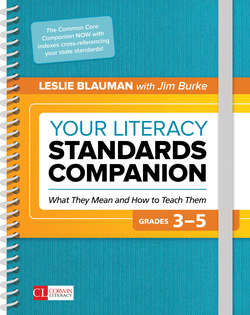Читать книгу Your Literacy Standards Companion, Grades 3-5 - Leslie Blauman - Страница 33
На сайте Литреса книга снята с продажи.
Common Core Reading Standard 2: What the Teacher Does
ОглавлениеTo determine the main idea, central message, lesson, or moral, or theme of a story, drama, or poem:
Point out common spots for identifying main idea/theme in a text and how you scrutinize specifics (TOC, headings, topic sentences, key events, recurring vocabulary, illustrations) to infer ideas throughout the text. Have students turn and talk whenever you want them to work through a key part where an important idea can be inferred.
Pose questions that get students looking for theme via the following avenues:Naming a lesson in the story (What lesson did ______________ learn by the end? What lesson or message did you get from reading this book?)Identifying a social issue in a story (What have you learned about ______________ from reading this book? What are you learning about the issue of ______________ here?)
Keep a classroom chart of themes that students discover in texts (with love and understanding, families can overcome loss; accept who you are; bullies lose out; perseverance pays off, and so on).
After skimming and scanning an informational text, ask students to generate all possible ideas and then determine which of them the text most fully develops.
Turn topic statements into questions that spur students to read the section for answers (Grey Wolf Habitat to “What is the Grey Wolf’s habitat?”). This will help students learn to “add up” subtopics toward a main idea.
To explain how it is conveyed through key details in the text:
Model for students how to code specific details in the text that support the central idea or theme.
Model for students using a shared text which words, phrases, or images recur throughout the text that might signal they are the main idea or central message. Mark, highlight, or annotate these words. After modeling, have students work in groups or independently using the same strategy.
To recount stories, including fables, folktales, and myths, from diverse cultures:
As you read aloud, introduce students to different types of stories, such as realistic stories, adventure stories, fantasy, folktales, fables, and myths. Compare and contrast, and chart their attributes.
Provide students with a variety of fables, folktales, and myths. Have students work in small groups to study a type in depth and share knowledge with class (e.g., Cinderella stories, Greek myths, American tall tales).
Model how to recount the story. First, explain that a retell/recount involves an opening statement, followed by key events listed in sequential or chronological order, and a conclusion; have students recount stories to a partner or with the class.
To summarize the text:
Create a shared summary with the class. Include an opening statement, key details in chronological order from the text, and a conclusion. Post on chart paper for students to refer to.
Model explaining the story by writing a summary. Refer back to text to “lift” specific words, phrases, or sentences and embed these into the explanation.
Have students write their own summaries, highlighting where they have used specific details and examples from the text.
To determine how characters in a story or drama respond to challenges, or how the speaker in a poem reflects upon a topic:
Have students use graphic organizers or flow charts to monitor how characters respond to challenges over the course of a text.
Model reading poetry and think aloud how the narrator reflects on the topic. Highlight or annotate places in the text where that is supported.
Have students practice by annotating poetry either on tablets or on photocopies or using sticky notes.
To help your English language learners, try this:
Have students draw pictures to reinforce setting, characters, and plot. Make certain that students understand the meaning of the academic vocabulary you’re using, such as “main character” or “main idea.”
For graphic organizer templates, see online resources at resources.corwin.com/literacycompanion3-5.
